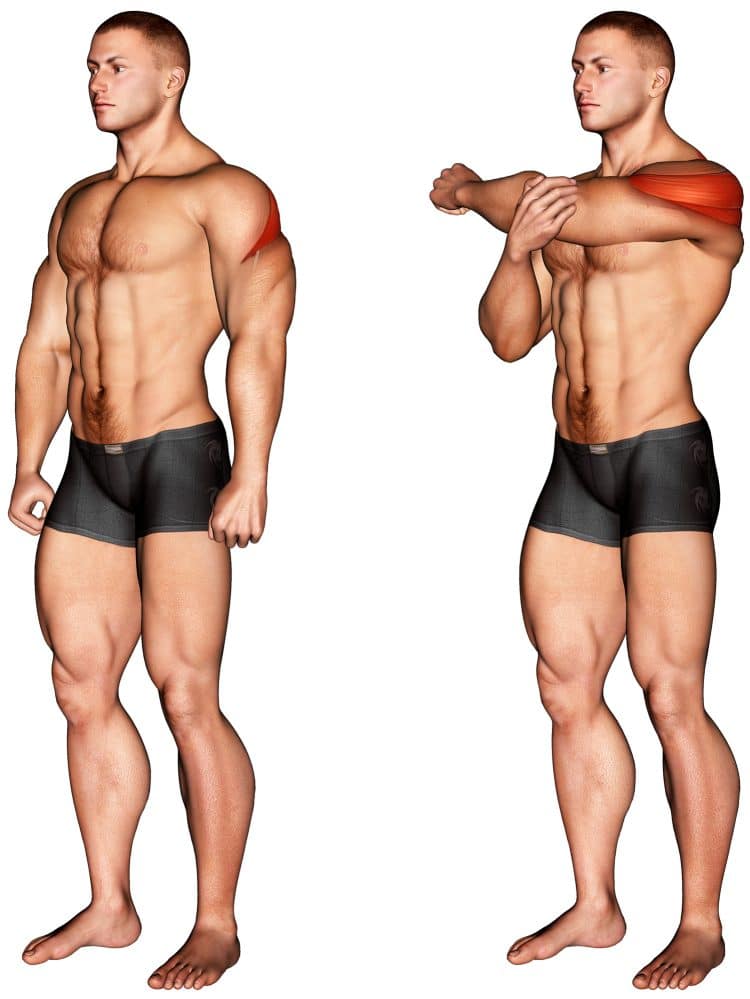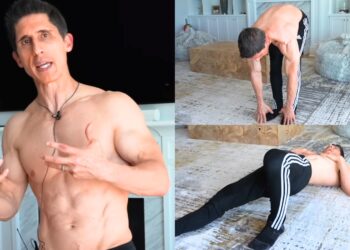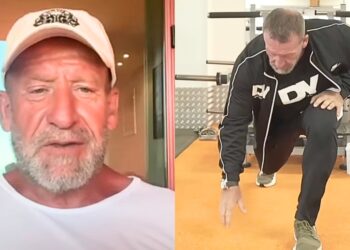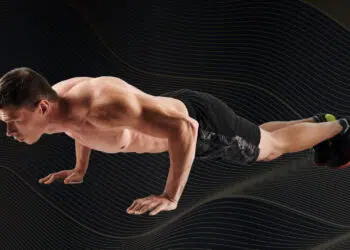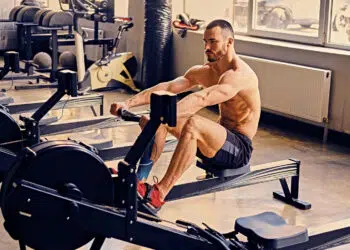Stretching a muscle effectively requires just as much attention to detail as training it. All too often, people think they’re getting a great stretch, when, in fact, they’re not. The rear deltoid stretch is a prime example of a common technique that’s often either misused, ineffective or does more damage than anything.
Frequent stretching helps keep your muscles loose, long and healthy, and the shoulders are especially in need of this as they’re involved in all upper body exercises and tend to be overtrained and overdeveloped from pressing variations. Not to mention, the ball and socket shoulder joint can be sensitive and vulnerable to issues.
Today we’ll explain the proper technique for the rear deltoid stretch and what not to do. Plus, we’ve included the right way to stretch the two other delts muscles – anterior and lateral.
Muscles Stretched
Before we stretch out your rear delts, you should understand why it’s important and what this muscle does. It’s also important to note that it’s not the only muscle being stretched using this technique. Read about their anatomy and function below.
Deltoid posterior
The deltoid posterior or rear delts makes up one of the three heads of the shoulder muscles. It attaches to the flat part of the scapula (shoulder blades) and its primary anatomical role is bringing the arms back behind the body (e.g., during row movements).
Level Up Your Fitness: Join our 💪 strong community in Fitness Volt Newsletter. Get daily inspiration, expert-backed workouts, nutrition tips, the latest in strength sports, and the support you need to reach your goals. Subscribe for free!
It also helps to stabilize the arms during abduction of the arms up and away from the body.
The rear delts don’t get as much attention compared to the front and especially lateral or outer deltoids. This could be for a few reasons including that they are not as popular compared to other posterior muscles, many think they get enough work from back exercises, or you cannot see these muscles when looking in the mirror.
But you’d be surprised how important they are in creating a rounded and 3D appearance. Underdeveloped rear delts can throw off a physique especially since all pressing movements train the front delts that are often overdeveloped.
Deltoid lateral
Also called the side or outer delts, the deltoid lateral is responsible for lifting the arm up and away from the body (abduction). It’s quite possibly the most prominent and visually aesthetic head, giving a cannonball like shape to the glenohumeral ball and socket shoulder joint.
Related: The 11 Best Chest Stretches for More Flexible Pecs and Healthier Shoulders
How To Do The Rear Deltoid Stretch
It’s important to pay attention to the details because it can make all the difference. Here we’ve included proper rear delts stretching technique that include a video demonstration.
To do it:
- Extend your left arm across your chest.
- Grab the left arm behind the elbow (lower triceps) with your right hand and press the arm against your body.
- Pull the arm forward and under in a scooping motion while leaning your body into the stretch. You should feel it in your rear deltoid muscle. Do not tug back and forth on the elbow but rather maintain a consistent static stretch.
- Hold the stretch for a minimum 15 seconds.
- Repeat on the opposite arm.
Watch the video below starting at the 3:40 mark where famous trainer and physical therapist Jeff Cavaliere shows the perfect technique to stretch your rear delts safely and effectively.
Pro tip: The key in stretching the rear delts is create distance between your elbow and body.
Wrong Way To Stretch The Rear Deltoids
What a lot of people will do in an attempt to stretch the rear delts to loosen up the shoulders and alleviate pain is they’ll grab underneath the opposite elbow and push it up toward the chin or flat against the pecs. These are not the most effective or safest ways to do it.
Pushing the elbow high can cause impingement if the shoulder joint is already crowded and bunched up, and stretching the arm across the chest focuses on the lateral deltoid muscles anatomically. You want to follow the fibers and think logically as to how you can best stretch a muscle due to its fiber direction.
Level Up Your Fitness: Join our 💪 strong community in Fitness Volt Newsletter. Get daily inspiration, expert-backed workouts, nutrition tips, the latest in strength sports, and the support you need to reach your goals. Subscribe for free!
That’s why Cavaliere demonstrated the scooping technique and it makes sense.
Stretching Anterior and Lateral Deltoids
While we’re here, we might as well stretch the other two deltoid heads. The video provided above also demonstrates how many do this wrong and how to get the best stretch in these muscles.
To do them:
Anterior deltoid stretch
Because the anterior or front delts starts from the clavicle bone above the pecs and attaches down onto the upper arm, we want to position the arms behind the body using the following technique to fully elongate the muscle fibers.
- Place your hands behind your back (don’t worry you’re not being arrested) in the center and grab one hand in the other. Slide your hands up your back until you cannot continue and then stick out your chest until you feel an intense stretch in your front deltoids.
Lateral deltoid stretch
Many do this stretch incorrectly because they’ll internally rotate the shoulder and press the back of the elbow/biceps into the chest. A bigger problem is feeling pain, discomfort, and little to no stretch in the target muscles. Here’s how to stretch the lateral delts head the right way.
- With your arm bent at a 90-degree angle, use your opposite hand to press it down and flat against the same side pec at a downward diagonal angle. Here you should be able to clearly see the muscle fibers in your side delts.
Hold your stretches for 5-15 seconds or longer and then repeat one or two more times.
Recent guide: How To Do The Middle Back Stretch – Tips, Benefits, and Alternatives
Why Stretch Your Rear Delts?
The shoulders are involved in darn near every upper body exercise including every pressing variation and all pulling movements. Consequently, they often become overdeveloped and tight, and the deltoids ball and socket joint makes it more prone to strain or injuries.
Tight shoulder muscles can limit mobility and flexibility in the joints which which will affect your training, physical performance and your ability to carry out normal day to day activities comfortably.
How Often To Stretch The Rear Delts
You don’t need to stretch the rear deltoids (or any muscle for that matter) everyday. However, two to three times per week minimum is a good number to aim for according to an article by Harvard Medical School (1).
If you’re very active or do resistance training then some light stretching after each session isn’t a bad idea.
When Should You Stretch Your Rear Delts?
As with any muscle group, the general consensus is you should stretch a muscle after some form of physical activity that causes blood flow to the area. Something as simple as pushups, or even rows are a good option. That way your muscles are warm and elastic rather than cold, tight, and more prone to injury.
How Long Should You Hold A Stretch?
This can depend on the individual and how often they perform stretches. But studies have shown that you want to spend at least 60 seconds or one minute on each stretch. You can also break it up into shorter durations or sets to complete a full minute of stretching activity. For example, if you stretch a muscle for 20 seconds, you’d take a short rest then do that twice more to equal 60 seconds.
Tip: While we always recommend having a structured weekly stretching routine, it’s also beneficial to stretch each muscle for at least 15-20 seconds after a workout.
Bottom Line
If you didn’t quite feel your rear delts being stretched using your previous technique then the one explained in this guide should do the trick. Once you understand how to position your body based on the anatomy of your muscle fibers, you’ll start to actually feel the stretches working and elongating the target muscle fibers. Also be sure you’re stretching your other shoulder heads the right way for healthy and balanced shoulders.
Also remember 60-seconds per stretch and it’s always a good idea to do it after training a muscle.

